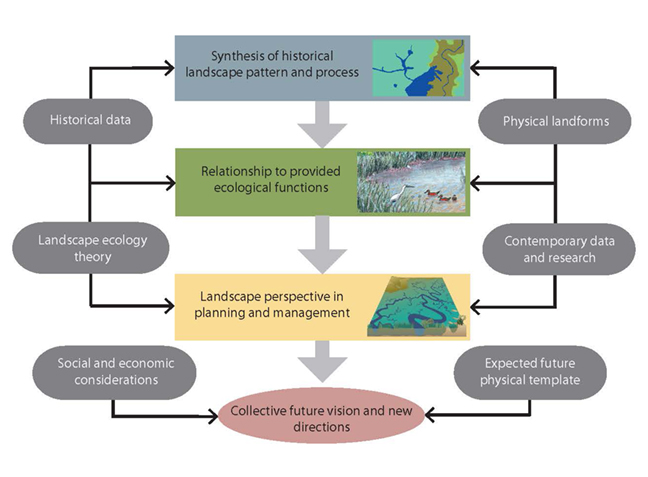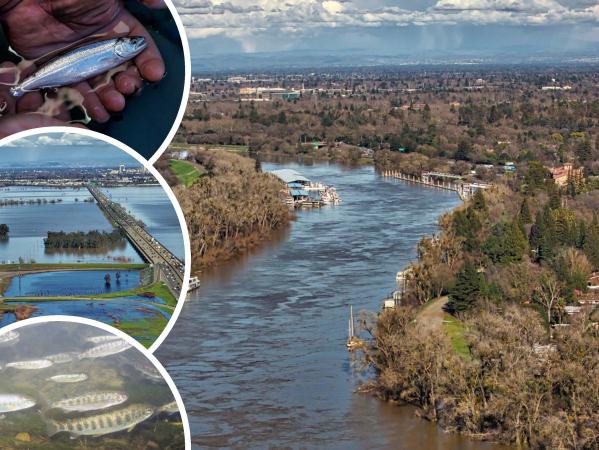Delta Landscapes Project
The Delta Landscapes Project has developed a body of work to inform landscape-scale restoration of the Sacramento-San Joaquin Delta ecosystem. The project is built on knowledge, first published in 2012’s Delta Historical Ecology Investigation, of how the Delta ecosystem functioned in the early 1800s (prior to the California Gold Rush and subsequent landscape-level changes). In two reports described below, A Delta Transformed and A Delta Renewed, project scientists identify how (1) the Delta has been altered over time and (2) how it might be altered again in the future to better support resilient populations of native wildlife. Given the nature and scale of the historical transformation, as well as expected future changes (such as climate change, sea-level rise, and flow alterations, amongst other factors), the goal of the project is not to recreate the Delta of the past. Rather the objective is to understand how we can re-establish or mimic certain natural processes, in an altered system, in order to provide desirable ecological function now and into the future.
Delta Landscapes Executive Summary
 A Delta Renewed:
A Delta Renewed:
A Guide to Science-Based Ecological Restoration in the Sacramento-San Joaquin Delta
This final report of the Delta Landscapes Project, A Delta Renewed, offers guidance for creating and maintaining landscapes that can provide desired ecological functions for decades to come.
Based on extensive research into how the Sacramento-San Joaquin Delta used to function, how it has changed, and how it is likely to evolve, we make recommendations for how to re-establish the dynamic natural processes that can sustain native Delta wildlife as healthy populations into the future. The approach, building on work others have piloted and championed, is to restore or emulate natural processes where possible, establish an appropriate configuration of habitat types at the landscape scale, and use multi-benefit management strategies to create a more viable Delta ecosystem that can adapt and continue to provide valued functions as the climate changes.
This approach is designed to integrate with the human landscape: ecosystem improvements as a part of a robust agricultural economy, water infrastructure and diversions, and urbanized areas. Strategic restoration which builds on the history and ecology of the region can contribute to the strong sense of place and recreational value of the Delta in the future.
This report is available online. Printed copies are also available for purchase.
Factsheet about A Delta Renewed
A Delta Renewed User Guide was developed to increase the accessibility of the technical findings in A Delta Renewed for easier application to restoration and conservation efforts across the Delta.
 A Delta Transformed:
A Delta Transformed:
Ecological Functions, Spatial Metrics, and Landscape Change in the Sacramento-San Joaquin Delta
In A Delta Transformed, completed in 2014, SFEI researchers used the spatial data generated in the Delta Historical Ecology Investigation, as well as updated modern vegetation and land cover datasets, to carry out detailed analyses of how the Delta landscape has been altered since the early-1800s. By quantifying changes in metrics relevant to native wildlife (such as the extent and timing of inundation, habitat patch sizes, length of channel networks), the report provides a foundation for defining, designing, and evaluating landscapes that support desirable ecological functions in the future.
 Sacramento-San Joaquin Delta Historical Ecology Investigation:
Sacramento-San Joaquin Delta Historical Ecology Investigation:
Exploring Pattern and Process
In 2012, SFEI researchers (in collaboration with the CA Department of Fish and Wildlife) completed a historical ecology study of the Sacramento-San Joaquin Delta. The project improves understanding of what the Delta looked like and how it functioned prior to the significant modification that has occurred over the last 160 years.
This historical reconstruction documents patterns of variation and extent of habitat types throughout the Delta for improved understanding of species support functions and controlling physical processes within the native landscape. Knowing how different parts of the vast historical Delta looked and functioned provides needed information for future restoration strategies.
This report is available online. Printed copies are also available for purchase.
Landscape Interpretation Team
The project draws upon a strong multidisciplinary team including:
Stephanie Carlson (UC Berkeley)
Jim Cloern (U.S. Geological Survey)
Brian Collins (University of Washington)
Chris Enright (Delta Science Program)
Joseph Fleskes (U.S. Geological Survey)
Geoffrey Geupel (Point Blue Conservation Science)
Todd Keeler-Wolf (California Department of Fish and Game)
William Lidicker (UC Berkeley)
Steve Lindley (NMFS)
Jeff Mount (UC Davis)
Peter Moyle (UC Davis)
Anke Mueller-Solger (Bay-Delta Interagency Ecological Program and Delta Science Program)
Eric Sanderson (Wildlife Conservation Society)
Hildie Spautz (California Department of Fish and Game)
Dave Zezulak (California Department of Fish and Game)
Project Downloads
Executive Summary (2017) Delta Landscapes Executive Summary
User Guide (2017) Delta Landscapes: A Delta Renewed User Guide
Report (2016) A Delta Renewed: A Guide to Science-Based Ecological Restoration in the Sacramento-San Joaquin Delta
- high resolution PDF for printing (121 Mb)
- medium resolution PDF for screen viewing (18 Mb)
Journal Article (Peer-Reviewed) (2016) in San Francisco Estuary and Watershed Science
Primary Production in the Delta: Then and Now (0.9 Mb)
Report (2016) in cooperation with and funded by USGS and the Delta Science Program
Primary Production in the Sacramento-San Joaquin Delta: A Science Strategy to Quantify Change and Identify Future Potential (19.8 Mb)
Report (2014) A Delta Transformed: Ecological Functions, Spatial Metrics, and Landscape Change in the Sacramento-San Joaquin Delta
- high resolution PDF for printing (59 Mb)
- medium resolution PDF for screen viewing (12 Mb)
- interactive ebook
- purchase a printed copy
- interactive map: Habitat Types in the Historical and Modern Delta
- interactive map: Marsh Patches in the Historical and Modern Delta
- interactive map: Marsh-Terrestrial Transition Zones in the Historical and Modern Delta
Presentation (2014) for the Bay Delta Science Conference
Delta Landscape Metrics: Creating a Spatial Framework to Inform Restoration Planning (8.4 Mb)
Poster (2013) for the State of the Estuary Conference
A landscape ecology analysis of San Francisco Bay-Delta marsh then (1850) and now (20.1 Mb)
Report (2013) for the Nature Conservancy
Landscape Patterns and Processes of the McCormack-Williamson Tract and Surrounding Area (21.3 Mb)
Poster (2012) for the Bay Delta Science Conference
Developing Tools for Landscape-Scale Restoration in the Delta (4.6 Mb)
Presentation (2012) for the Bay Delta Science Conference
Historical Ecology and Landscape-Scale Restoration: Application to the McCormack-Williamson Tract (110 Mb)
Project Press
2016
Water Deeply (Tara Lohan)- "New Report Offers Framework for California Delta Restoration"
Water Education Foundation (Gary Pitzer)- "Delta Report Highlights Need to Restore Legacy Processes"
The Record (Alex Breitler)- "Future look for the Delta?"
Greenwire (Debra Kahn)- "Report finds 'cause for hope' in healing Calif. estuary"
2014
The Record (by Michael Fitzgerald)- "The Delta That Ceased to Be"
Department of Fish and Wildlife- "Report Reveals Dramatic Changes to Delta Ecosystem"
KQED (by Lauren Sommer)- "Why California’s Largest Estuary No Longer Works for Wildlife"
KCET (by Chris Clarke)- "Report: Sacramento Delta 'No Longer a Delta'"
The Record (by Alex Breitler)- "The Delta Hardly a Delta Anymore"
Central Valley Business Times- "Report Reveals Dramatic Changes to Delta Ecosystem"
Project Status
This project is scheduled for completion in 2016
Contact
Associated Staff:
Associated Data:
Programs and Focus Areas:
Design and Communications
Resilient Landscapes Program
Delta Science & Management
Historical Ecology
Center for Resilient Landscapes












